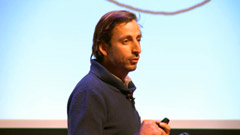Fernando García-Dory
The Leonore Annenberg Prize for Art and Social Change is an annual $25,000 award, generously supported by the Annenberg Foundation, honoring an artist who has committed his or her life’s work to promoting social justice in surprising and profound ways. This year, Creative Time has the privilege of awarding the Annenberg Prize to Spanish artist, activist and agroecologist Fernando García-Dory. His exceptional body of work focuses on the relationship between contemporary culture and the natural world, exploring the physical, psychological and social impact of post industrial capitalism in life and upon rural landscapes, including the questions and (mis)conceptions of identity, desire and utopia that they provoke. García-Dory was chosen as the winner of this year’s Prize by a panel of three distinguished judges: Tom Finkelpearl, Executive Director of the Queens Museum of Art, curator Jack Persekian, and the 2011 Annenberg Prize recipient, Dutch artist Jeanne van Heeswijk.
Driven by a belief that art must be “proactive, not just reactive action,” García-Dory has become a leader in the field of socially engaged art and a pioneer of a new field connecting art and agroecology. Although the artist’s studio works include sculpture and painting, his larger projects extend far beyond the boundaries of traditional art practice. García-Dory’s work has permanently engaged and transformed one of the world’s most underrepresented and—at a population of an estimated 250 million—widespread communities: the pastoralist and nomadic peoples.
García-Dory first became interested in pastoralism upon coming into contact with shepherds in the Spanish Pyrenees mountains, leading him to establish The Shepherd’s School in 2004. The success of the School prompted García-Dory to explore the larger nomadic populations outside of his native Spain. In 2007, the artist organized a conference that brought together two hundred representatives of nomadic and transhumanist pastoralist communities from forty-four different countries. He had first intended the project to serve as a platform for discussion and “mutual recognition” between these groups, but it quickly became much more. García-Dory’s gathering resulted in the creation of the World Alliance of Mobile Indigenous Pastoralists (WAMIP), a global organization that provides unprecedented representation and advocacy for these communities on an international scale.
Most recently, García-Dory has collaborated with American artist Amy Franceschini in Land/Use. A Blueprint for New Pastoralism, presented at the David Brower Center in Berkeley, California. The multi-part show transformed the gallery into a functional exhibition space promoting discussion as well as visual engagement with the surrounding works pertaining to environmental activism. García-Dory’s work has been shown at museums and galleries internationally, including the Barcelona Museum of Contemporary Art (MACBA), the Tate Britain in London and the Museo Reina Sofía in Madrid. Additionally, he was the recipient of the 2009 Artistic Production Grant from the Laboral Center of Art and Industrial Creation, the Youth Commissions Grant of the European Union (2003-2005), and the Rolex Awards for Young Enterprise (2010). This year, Garcia Dory was a contributor to the dOCUMENTA (13) publication 100 Notes – 100 Thoughts.

